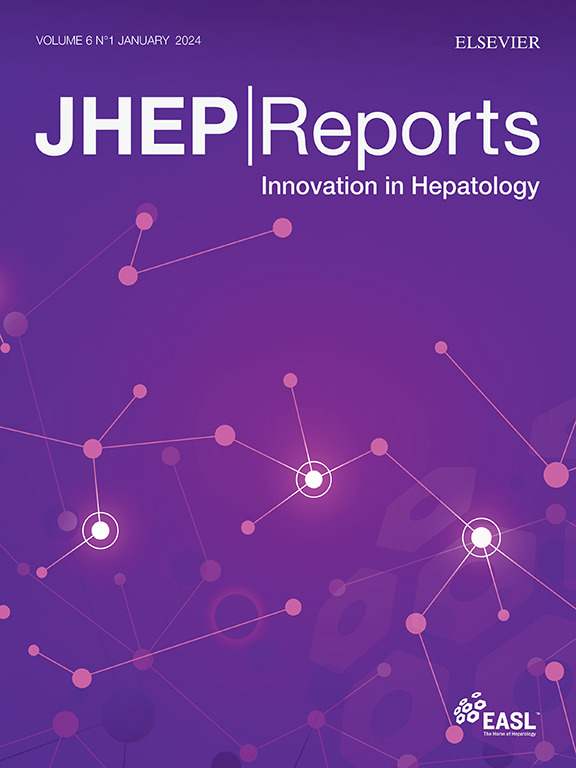一项比较生活方式减肥和GLP-1受体激动剂治疗MASLD患者的随机试验
IF 9.5
1区 医学
Q1 GASTROENTEROLOGY & HEPATOLOGY
引用次数: 0
摘要
背景,目的胰高血糖素样肽1受体激动剂(GLP-1RA)治疗为代谢功能障碍相关脂肪变性肝病(MASLD)患者提供组织学益处。多种机制可能是重要的,包括体重减轻,改善血糖控制和假定的直接组织特异性作用。停止GLP1-RA治疗后,体重恢复是常见的。为了分析其益处的机制,我们在MASLD患者中进行了一项前瞻性,随机,实验医学研究,比较GLP-1RA治疗(利拉鲁肽)与匹配的生活方式诱导的体重减轻,并评估治疗停药的影响。方法29例无2型糖尿病的MASLD患者进行代谢表型分析,包括测量新生脂肪生成(DNL)、肝脏磁共振成像、身体组成、脂肪组织RNA测序、循环蛋白质组和粪便微生物组分析。参与者被随机分配到生活方式(~ 500千卡能量赤字)或GLP1-RA治疗组,持续12周,之后重复调查,并停止治疗;停药12周后再次进行调查。结果两组患者均达到了相应的减重效果。两种治疗后,机体成分变化、丙氨酸转氨酶减少、肝脏脂肪变性和疾病活动度相似。GLP-1RA治疗,而不是生活方式,改善葡萄糖处理,空腹血脂和显著死亡的DNL。治疗后各组皮下脂肪转录组、循环蛋白质组和粪便微生物组无显著差异。然而,在GLP1-RA(而不是生活方式)停用12周后,循环MMP-10、IL10RB、FGF-23和Flt3L升高,同时脂肪基因表达失调。结论:虽然通过生活方式或GLP-1RA匹配的体重减轻对肝脂肪变性有相当的影响,但GLP-1RA治疗对葡萄糖稳态、脂质谱和DNL有额外的代谢益处。然而,停用GLP-1RA可能会对循环蛋白质组、脂肪组织基因表达和粪便微生物组产生不利影响,容易导致体重反弹。影响和意义通过生活方式干预或GLP-1RA药物治疗减肥对肝脏有同样有益的影响,在MASLD患者的管理中应考虑这两种策略。GLP-1RA治疗可能对改善葡萄糖稳态有额外的好处,即使在没有2型糖尿病的情况下。需要进一步的研究来探索治疗停药的不同影响和由此产生的代谢后果。临床试验注册本研究已在EudraCT注册(2016-002045-36)。本文章由计算机程序翻译,如有差异,请以英文原文为准。

Randomised trial comparing weight loss through lifestyle and GLP-1 receptor agonist therapy in people with MASLD
Background & Aims
Glucagon-like peptide 1 receptor agonist (GLP-1RA) therapies deliver histological benefit in people with metabolic dysfunction-associated steatotic liver disease (MASLD). Multiple mechanisms may be important including weight loss, improved glycaemic control and putative direct tissue-specific actions. Following cessation of GLP1-RA therapy, weight regain is common. To dissect the mechanisms underpinning their benefits, we conducted a prospective, randomised, experimental medicine study in people with MASLD, comparing GLP-1RA treatment (liraglutide) to matched lifestyle-induced weight loss and assessed the impact of treatment withdrawal.
Methods
Twenty-nine participants with MASLD, without type 2 diabetes underwent metabolic phenotyping including measurement de novo lipogenesis (DNL), liver magnetic resonance imaging, body composition, adipose tissue RNA sequencing, circulating proteome, and stool microbiome analysis. Participants were randomised to lifestyle (∼500 kcal energy deficit) or GLP1-RA treatment for 12 weeks, after which investigations were repeated, and treatment stopped; investigations were also repeated 12 weeks after treatment withdrawal.
Results
Matched weight loss was achieved in both arms. Body composition changes, reductions in alanine aminotransferase, liver steatosis, and disease activity were similar following both treatments. GLP-1RA treatment, but not lifestyle, improved glucose handling, fasting lipids, and significantly deceased DNL. The subcutaneous adipose transcriptome, circulating proteome profile and stool microbiome were not different between groups after treatment. However, 12 weeks after GLP1-RA (but not lifestyle) withdrawal, circulating MMP-10, IL10RB, FGF-23, and Flt3L were elevated, alongside dysregulated adipose gene expression.
Conclusions
Although matched weight loss through lifestyle or GLP-1RA have comparable effects on hepatic steatosis, GLP-1RA treatment had additional metabolic benefits on glucose homeostasis, lipid profiles, and DNL. However, GLP-1RA withdrawal may adversely impact the circulating proteome, adipose tissue gene expression, and the stool microbiome, predisposing to weight regain.
Impact and implications
Weight loss, through either lifestyle intervention or pharmacotherapy with GLP-1RA has an equally beneficial impact on the liver, and both strategies should be considered in the management of people with MASLD. GLP-1RA therapy may have additional benefits to improve glucose homeostasis even in the absence of pre-existing type 2 diabetes. Further research is needed to explore the differential impact of treatment withdrawal and the resultant metabolic consequences.
Clinical Trials Registration
This study is registered at EudraCT (2016-002045-36).
求助全文
通过发布文献求助,成功后即可免费获取论文全文。
去求助
来源期刊

JHEP Reports
GASTROENTEROLOGY & HEPATOLOGY-
CiteScore
12.40
自引率
2.40%
发文量
161
审稿时长
36 days
期刊介绍:
JHEP Reports is an open access journal that is affiliated with the European Association for the Study of the Liver (EASL). It serves as a companion journal to the highly respected Journal of Hepatology.
The primary objective of JHEP Reports is to publish original papers and reviews that contribute to the advancement of knowledge in the field of liver diseases. The journal covers a wide range of topics, including basic, translational, and clinical research. It also focuses on global issues in hepatology, with particular emphasis on areas such as clinical trials, novel diagnostics, precision medicine and therapeutics, cancer research, cellular and molecular studies, artificial intelligence, microbiome research, epidemiology, and cutting-edge technologies.
In summary, JHEP Reports is dedicated to promoting scientific discoveries and innovations in liver diseases through the publication of high-quality research papers and reviews covering various aspects of hepatology.
 求助内容:
求助内容: 应助结果提醒方式:
应助结果提醒方式:


